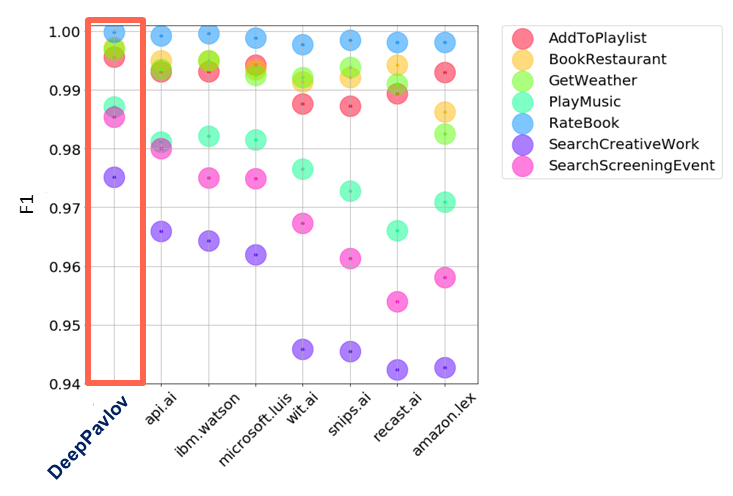deepmipt / Intent_classifier
Programming Languages
Projects that are alternatives of or similar to Intent classifier
This repo is not currently supported as intent classifier became a part of DeepPavlov open-source library.
Try it here.
Neural Networks for Intent Classifier
In this repo one can find code for training and infering intent classification that is presented as shallow-and-wide Convolutional Neural Network[1].
Currently considered fasttext version in this repo does not works on Windows correctly.
Also this repo contains pre-trained model for intent classification on SNIPS dataset
SNIPS dataset considers the following intents: AddToPlaylist, BookRestaurant, GetWeather, PlayMusic, RateBook, SearchCreativeWork, SearchScreeningEvent.
Test results for other intent recognition services are from https://www.slideshare.net/KonstantinSavenkov/nlu-intent-detection-benchmark-by-intento-august-2017
How to install
First of all, one have to download this repo:
git clone https://github.com/deepmipt/intent_classifier.git
cd intent_classifier
The next step is to install requirements:
pip install -r requirements.txt
How to use pre-trained model (SNIPS)
Now one is able to infer pre-trained model:
./intent_classifier.py ./snips_pretrained/snips_config.json
The script loads pre-trained model, if necessary downloads pre-trained fastText embedding model [2], and then it is ready to predict class and probability of given phrase to belong with this class.
Example:
./intent_classifier.py ./snips_pretrained/snips_config.json
>I want you to add 'I love you, baby' to my playlist
>(0.99986315, 'AddToPlaylist')
How to train on your own data
The repo contains script train.py for training multilabel classifier.
Training data file should be presented in the following data.csv form:
| request | class_0 | class_1 | class_2 | class_3 | ... |
|---|---|---|---|---|---|
| text_0 | 1 | 0 | 0 | 0 | ... |
| text_1 | 0 | 0 | 1 | 0 | ... |
| text_2 | 0 | 1 | 0 | 0 | ... |
| text_3 | 1 | 0 | 0 | 0 | ... |
| ... | ... | ... | ... | ... | ... |
Then one is ready to run train.py that includes reading data, tokenization, constructing data,
building dataset, initializing and training model with given parameters on dataset from data.csv:
./train.py config.json data.csv
The model will be trained using parameters from config.json file.
There is a description of several parameters:
-
Directory named
model_pathshould exist. For example, ifconfig.jsoncontains"model_path": "./cnn_model", then configuration parameters for the trained model will be saved to./cnn_model/cnn_model_opt.jsonand weights of the model will be saved to./cnn_model/cnn_model.h5. -
Parameter
model_from_savedmeans whether to load pre-trained model -
Parameter
lear_metricsis a string that can include either metrics fromkeras.metricsor custom metrics from the filemetrics.py(for example,fmeasure). -
Parameter
confident_thresholdis within the range[0,1]and means the boundary whether sample belongs to the class. -
Parameter
fasttext_modelcontains path to pre-trained binary skipgram fastText [2] model for English language. If one prefers to use default model, it will be downloaded when one will train model. -
Parameter
text_sizemeans the number of words for padding of each tokenized text request. -
Parameter
model_namecontains name of the class method frommulticlass.ryreturning uncompiled Keras model. One can usecnn_modelthat is shallow-and-wide CNN (config.jsoncontains parameters for this model),dcnn_modelthat is deep CNN model (be attentive to provide necessary parameters for the model), also it is possible to write own model. -
All other parameters refer to learning and network configuration.
How to infer
Infering can be done in two ways:
./infer.py config.json
or
./intent_classifier.py config.json
The first one runs infer.py file that contains reading parameters from config.json file, initializing tokenizer,
initializing and infering model. The second one is doing the same but reads samples from command line.
References
[1] Kim Y. Convolutional neural networks for sentence classification //arXiv preprint arXiv:1408.5882. – 2014.
[2] P. Bojanowski*, E. Grave*, A. Joulin, T. Mikolov, Enriching Word Vectors with Subword Information.

